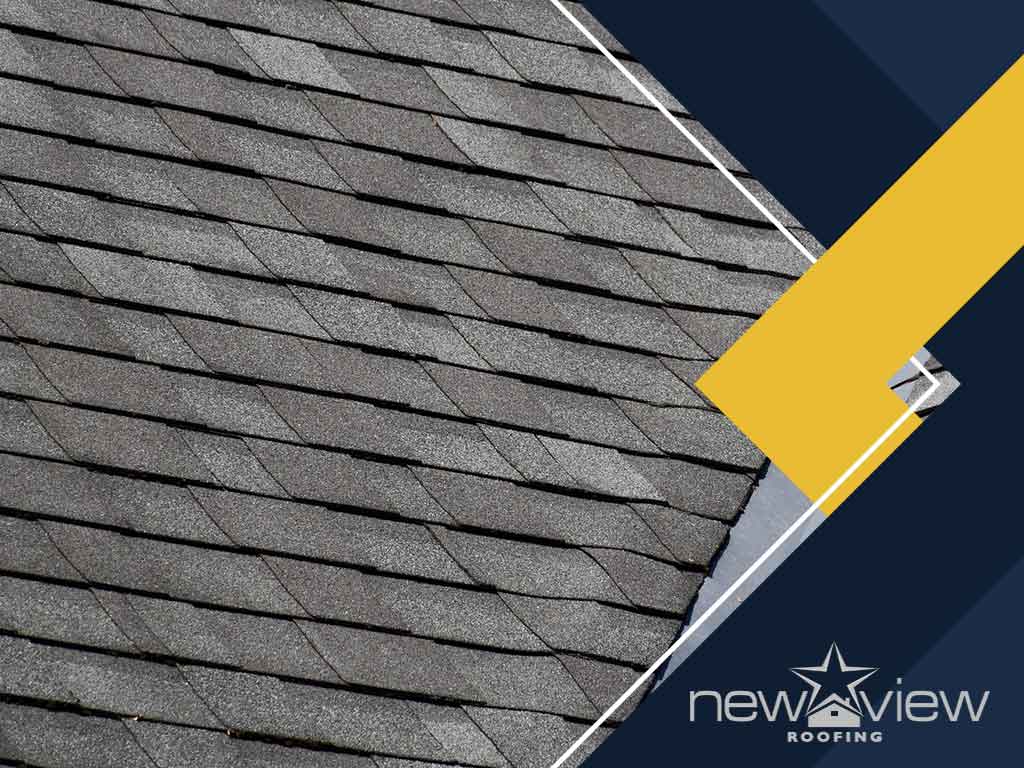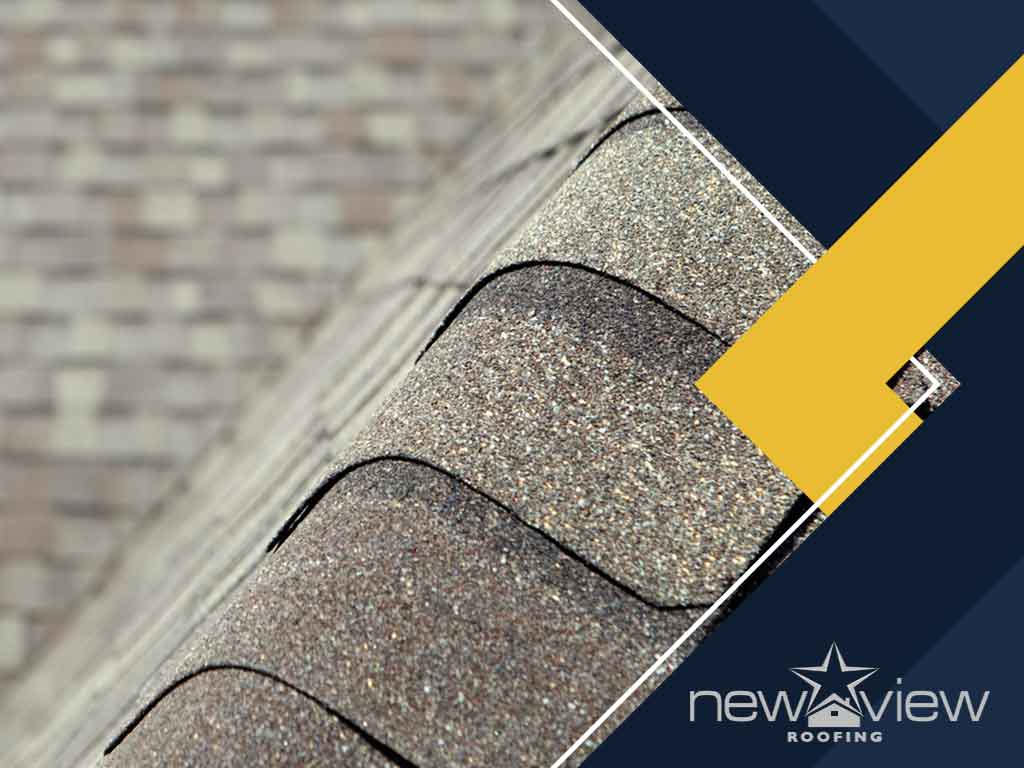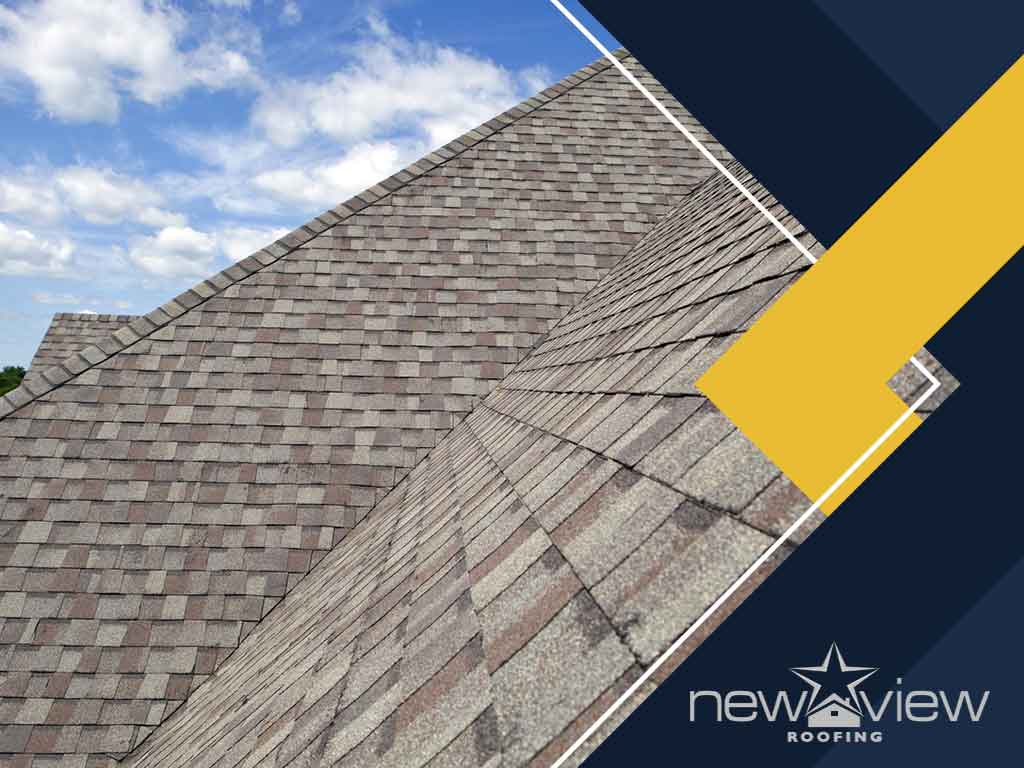Your roof is one of the biggest investments you’ll ever make, and so it only makes sense to maintain and use it for as long as possible. However, there are many factors that can affect its lifespan. While using the right materials can dramatically increase your roof’s ability to withstand the elements, that doesn’t mean your roof is never going to encounter other problems.
New View Roofing, one of the premier roofing contractors in the area, discusses the forces and conditions that will determine your asphalt roof’s performance, signs of damage and its stages of aging.
4 Factors That Affect the Life of an Asphalt Shingle Roof
Several factors affect the lifespan of an asphalt shingle roof, including shingle quality, installation procedure, the elements, and the level of maintenance you’ve undertaken during your roof’s life. The following sections explain.
 1. Shingle Quality
1. Shingle Quality
Asphalt shingles are known for their affordability, style, energy efficiency and durability. When it comes to longevity, though, other options like tile and metal have a higher rating. That is because an asphalt roof typically only lasts for 20 years compared to other materials that can still perform well for up to 60 years.
2. Installation Procedure
Installation mistakes are the leading cause of premature roof failure. There are many residential roofers in Texas, but you should only turn to one with an excellent reputation and has been in the business for years, such as New View Roofing. If you hire a fly-by-night worker, you could end up replacing your roof sooner than expected.
3. The Elements
This is one factor that you simply can’t control. High-quality shingles that were installed correctly will have a higher resistance to the elements, but, over time, the repeated barrage of hail, wind, rain and extreme temperatures will wear the system down.
4. Level of Maintenance
You need to maintain your roofing system. If you take a long time to address minor issues, they could spread and compromise the entire structure. Forgoing specific upkeep duties can also invalidate your insurance repair warranty.
4 Common Signs of Shingle Damage
The roof takes the brunt of storm damage and other elements on a daily basis, and that’s why it’s important to keep it in top shape. Deteriorating asphalt shingles can allow water to leak into your house and cause many other types of problems. If you suspect that your roof is showing signs of damage – like the signs below – have a professional evaluate the structure to see if you need a roof repair or roof replacement.
- Shingles that are lifted at the bottom are more prone to being blown off in high winds or penetrated by rainwater and snow. This usually happens when the sealing was not done properly during installation, or it could also be a sign of aging.
- When you see curling on the edge or corners of the shingles, you should call a roofer like New View Roofing to fix the problem. Curled shingles often signal that the roof is reaching the end of its useful life. In other cases, the poorly ventilated attic causes premature roof failure.
- This is one of the more obvious signs of shingle damage. Missing shingles will expose the area to the elements, allowing water to seep in and spreading the damage to other shingles. Call us after a storm and we’ll check for missing shingles after a high winds. If your roof is still relatively new and in good condition, you might have to just replace the damaged section.
- Just like any gaps in the shingles, cracks provide an easy entry point for water to flow beneath the surface and into your home. Temperature swings, high winds, improper installation and manufacturing defects are the usual culprits for shingle cracking.
The 3 Stages of Asphalt Shingle Aging and Deterioration
 All roof materials have a shelf life, including asphalt shingles. From manufacture to the point of functional failure, asphalt shingles usually only last for up to 50 years. New View Roofing, one of the top residential roofing contractors in the area, talks about what happens when an asphalt shingle ages and deteriorates.
All roof materials have a shelf life, including asphalt shingles. From manufacture to the point of functional failure, asphalt shingles usually only last for up to 50 years. New View Roofing, one of the top residential roofing contractors in the area, talks about what happens when an asphalt shingle ages and deteriorates.
Incipient Deterioration
This starts right after you take the material out of its packaging. Aging starts as soon as the shingles get exposed to the air, and different factors like heat or pressure can accelerate this process. Further wear happens after roof installation.
Wind, rain and sun exposure can all cause the shingles to lose some granules. Over the years, your asphalt shingle roof will undergo chemical changes. However, they won’t really be visible during your roof’s early years.
Accelerating Deterioration
When signs of damage have become more apparent and pronounced, your asphalt roof has entered the “accelerating deterioration” phase. In this situation, random cracks and gaps surface, and become more widespread. The bond between the granules and the flaps will degrade significantly, and the system tends to absorb more moisture.
If this is happening, get in touch with a pro like New View Roofing that will inspect and maintain your roof to mitigate this problem.
Decelerating Deterioration
At this stage, the previously high-quality asphalt shingles are back to their raw form. They won’t have resistance to the weather and can’t keep your home comfortable anymore. Normally, you shouldn’t wait to get to this point to get a replacement.
How Can You Tell if Your Asphalt Shingles Are Deteriorating Without a Professional Roof Inspection?
New View Roofing offers free roof inspections at least once a year and after major storms. However, if you suspect that your asphalt shingles are deteriorating and you aren’t yet ready to get a professional roofing inspection done, there are a few ways you may be able to tell, including:
- Shingle age
- Whether they’re curling or buckling
- Whether they’re missing
- If they have bald spots
- If they appear discolored or faded
- You notice cracks or brittle texture
- You see moss or algae growth
- You find leaks inside your home
The following sections explain.
Shingle Age
 Most asphalt shingles are made to last between 20 and 30 years, and that lifespan depends on various factors, such as climate, installation quality, material quality and maintenance. If your shingles are approaching the end of the normal asphalt shingle lifespan, or if they’ve already exceeded it, there’s a good chance that they aren’t protecting your home the way they should. It may be time to consider a roof repair or a complete roof replacement simply based on shingle age alone. A good rule of thumb to follow is that if your neighbors had their homes built around the same time yours was built, and you see them getting roof repairs or roof replacements, it’s probably time for you to do the same.
Most asphalt shingles are made to last between 20 and 30 years, and that lifespan depends on various factors, such as climate, installation quality, material quality and maintenance. If your shingles are approaching the end of the normal asphalt shingle lifespan, or if they’ve already exceeded it, there’s a good chance that they aren’t protecting your home the way they should. It may be time to consider a roof repair or a complete roof replacement simply based on shingle age alone. A good rule of thumb to follow is that if your neighbors had their homes built around the same time yours was built, and you see them getting roof repairs or roof replacements, it’s probably time for you to do the same.
Curling and Buckling
Sometimes a walk around your property can give you a good look at your roof’s condition. From the ground, look to see whether any of your shingles are curling up at the edges or appear to be buckling.
Curling can occur in two ways. One is cupping, where the edges of the shingles turn upward. The other is clawing, where the middle of the shingle begins to lift. Both types of curling indicate that the shingles are losing their shape and may be deteriorating.
Missing Shingles
A shingle that isn’t there can’t protect your home. If you notice missing shingles from the ground, the others may be about to disappear, as well. Sometimes shingles simply come loose from their fasteners overtime, and other times, weather events knock them loose. In either case, the older your shingles are, the more likely they are to deteriorate to the point that they fall off your roof more easily than newer shingles would.
Bald Spots on Shingles
Shingles are covered in tiny granules that help them shed water. However, these granules can wear off, and when they do, the shingles can’t protect your home as well as they used to. Granule loss is a sure sign of shingle deterioration, as the granules also protect the asphalt layer from ultraviolet rays.
Even if you don’t see any bald spots on your shingles from the ground, check your gutters and the areas around your downspouts for tiny granules. Often, rain washes these granules away from your home and into your gutters. If your gutters aren’t working properly, you should also inspect the area around your home’s foundation, directly beneath the roof line, for shingle granules. If you find them there, you need your shingles repaired or replaced and you need gutter work done.
Discoloration and Fading
Discolored or faded shingles may indicate that they’re deteriorating. That can mean that the protective granules have worn off, or that your shingles have become weathered. Often, the granules provide the color in your shingles. Because those granules protect the asphalt in your shingles from UV rays, and because they help your roof shed water, when they’re missing, your singles can’t protect your home.
Brittle or Cracked Shingles
If your shingles appear cracked, split or brittle, it’s a sign they’re deteriorating. Overtime, asphalt shingles can suffer under exposure to weather. They can become more susceptible to damage from wind, impacts, and thermal expansion and contraction. Any type of damage can make them begin to deteriorate.
Moss and Algae Growth
Moss and algae growth can be harmful to your roofing materials. In fact, if you notice the growth of moss, algae or any other type of vegetation on your shingles, they are most likely retaining water and probably deteriorating. Moss and algae can trap moisture, which will lead to accelerated shingle decay.
Leaks Inside Your Home
One of the most common reasons for roofs to fail is shingle deterioration. Although leaks aren’t always related to shingle deterioration, they’re a good sign that your roof isn’t working the way it should. Either way, it’s important that if you notice a leak, you get in touch with a roofing expert immediately. We can send an expert inspector to your home to find the source of the leak, determine the extent of the damage, and recommend repairs or roof replacement.
Some of the most common signs of leaks include water stains, discoloration, bubbled or blistering paint, or peeling paint on ceilings or walls.
Why Do People Choose Asphalt Shingles if They Deteriorate?
Many people choose asphalt shingles for their roofs, despite the fact that they can deteriorate over time. That’s because asphalt shingles are among the most versatile roofing materials, and, if you think about it, all roofing materials eventually deteriorate. Some of the main reasons people choose asphalt over other types of roofing materials include:
- Cost effectiveness. Asphalt shingles are among the most effective roofing materials, and they perform well. Particularly when compared to other roofing materials, such as metal, clay tiles and slate, these shingles have lower upfront costs that make them an attractive choice for homeowners who are on a budget or who want a cost-effective roofing solution.
- Asphalt shingles are very versatile. They come in a wide range of styles, colors and designs. When you choose asphalt shingles, you have the flexibility to create the look you want for your home.
- Ease of installation. Asphalt shingles are among the easiest roofing materials to install, which means you end up saving on labor costs when you choose them. Additionally, when they need to be repaired or replaced, they’re easier to deal with.
- There isn’t usually a waiting period for asphalt shingles to arrive in a warehouse, unlike those involved in other roofing materials. Usually, asphalt shingles can be found nearly anywhere.
- Effective performance. Although asphalt shingles deteriorate over time, they still provide adequate protection for the average residential roof. As long as they’re properly installed and maintained, asphalt shingles can withstand a huge range of weather conditions, including rain, snow, wind and hail. With regular inspections and timely repairs, your asphalt shingles will enjoy the longest possible lifespan and perform exactly as you expect them to.
Asphalt shingles are some of the most cost-effective roofing materials on the market, but every homeowner should understand their life cycle. New View Roofing, one of the leading roofers in the region, can inspect your entire roof and perform necessary repairs and help with all your roofing projects. Call us today or fill out our contact form to get started.








